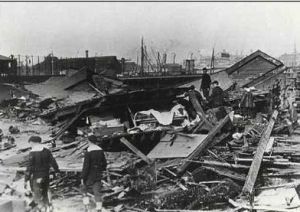
On her blog about U.S. Presidents and food, “The History Chef”, Suzy Evans, J.D., Ph.D tells the story of the famous North End’s Molasses Disaster of 1919 and how it relates to prohibition and President Woodrow Wilson.
Woodrow Wilson, Prohibition and the Molasses Disaster of 1919
What does this have to do with President Woodrow Wilson and food? Well, by coincidence, the day after the disaster, Congress ratified the 18th Amendment of the United States Constitution, which prohibited the manufacture, sale, and distribution of intoxicating liquors. With Prohibition looming on the horizon, rumors began to circulate which held that the tank had been overfilled to enable the owners of the distillery to produce as much rum as quickly as possible before the law took effect.
This claim was later proven untrue due to the fact that the distillery didn’t make rum and specialized instead in the production of industrial alcohol, which was exempt from the state prohibition laws in effect at the time, and would later be exempted from the Volstead Act, which was passed by Congress on October 27, 1919 over President Wilson’s veto.
FOOD FACT: Molasses was once used in the United States as the primary sweetener in cooking and baking. According to the Oxford Encyclopedia of Food and Drink, New England colonists also used molasses “as an ingredient in brewing birch beer and molasses beer and in distilling rum.” In the early 1700s, “rum made in New England became an essential element in a highly profitable Triangular Trade across the Atlantic.


